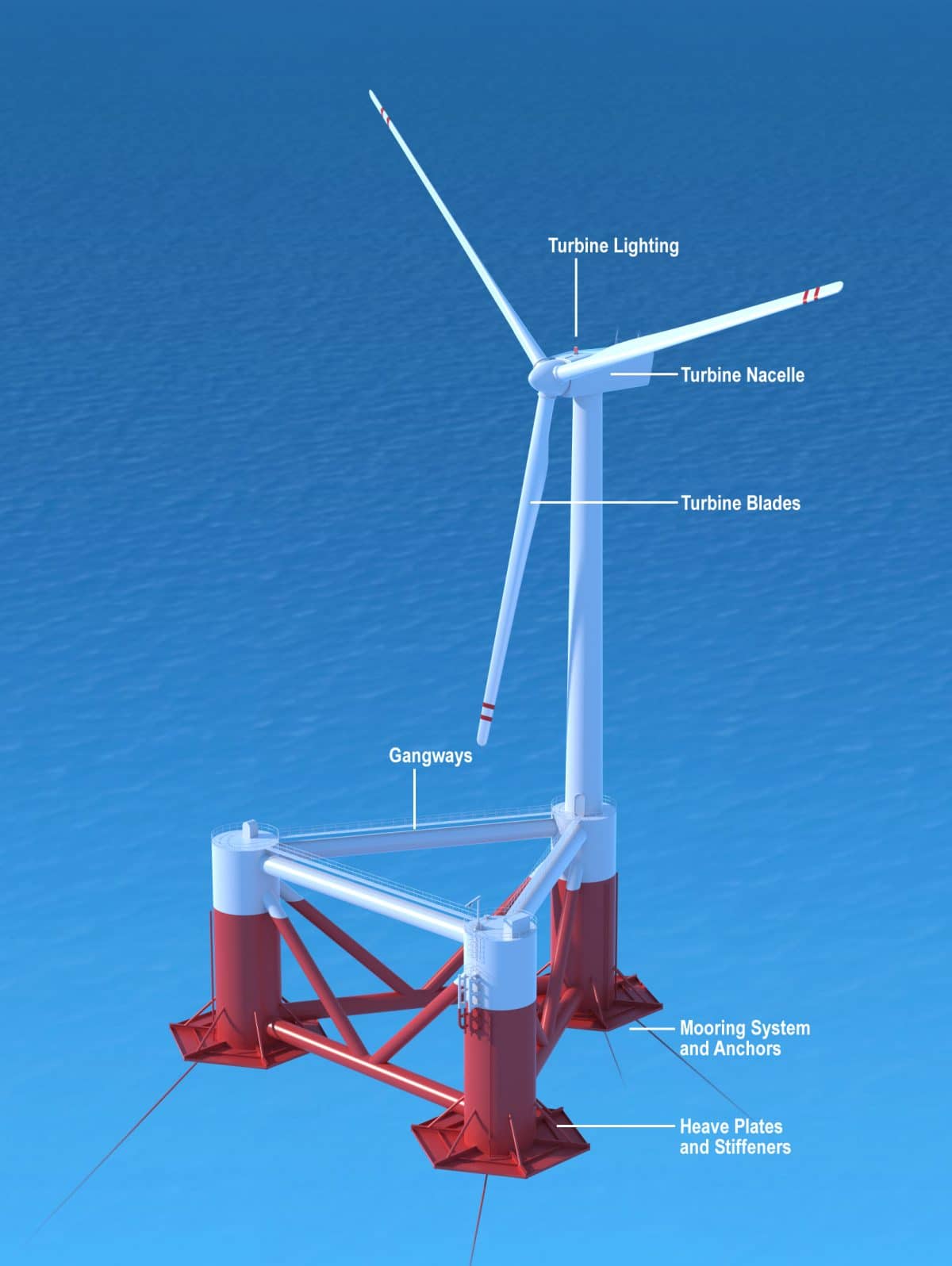
Background
It is estimated that nearly 80% of the wind resources at sea in Europe are located in waters of +60 meters deep, where the cost of the structures installed is not economically attractive.
Principle Power company, founded in 2007 in the United States, has created a semi-submersible floating platform for offshore wind turbines, called Windfloat, inspired by offshore O&G concepts.
Windfloat, floater characteristics
The device combines a three-columns semi-submersible concept and a standard wind turbine. Windfloat has a patented heave plates system at the base of each of its three columns. These heave plates significantly improve the stability of the system by damping swell movements, increasing the mass of entrained water and vortex detachment.
- stability that allows movements under the impact of swells and waves weak enough to add an existing wind turbine without modification,
- active ballasting of the floating foundation to compensate for the average inclination of the wind turbine,
- a design and dimensions that allow onshore assembly reducing manufacturing and installation costs
- a shallow draft (10 meters minimum and up to 20 meters depending on the power of the wind turbine) allowing access to shallow sites and manufacturing in shallow water ports
WINDFLOAT 1, a first project validating the technology in 2011
In October 2011, a first demonstrator was installed 5 km off the coast of Portugal. It is coupled with a 2 MW Vestas V80 turbine.
Testing of the Windfloat 1 prototype was stopped in June 2016. During its operation Windfloat 1 faced waves 17 meters high and winds exceeding 60 knots (110 km / h). The demonstrator would have met, if not exceeded, all of the team’s expectations, and makes it possible to consider the first projects of pre-commercial farms. The platform has been disconnected from the grid and freed from its moorings to be taken ashore for dismantling.
WINDFLOAT Atlantic
In November 2015, EDP Renewables (EDPR), Mitsubishi Corporation, Chiyoda Corporation, Engie and Repsol announced an agreement to implement a floating offshore wind farm off the northern coast of Portugal, located 20 kilometers off Viana do Castello, in a depth of 100 meters, called Windfloat Atlantic (WFA) Project.
This project consists of 3 Windfloat floating wind turbines for a total capacity of 25 MW. WFA receives support from the European Commission through the NER 300 program and support from the Portuguese government through the Portuguese Carbon Fund. He was also selected for the InnovFin program by the European Investment Bank. On the date of their commissioning, the three 8.4 MW turbines will be the largest and most powerful wind turbines ever installed on a floating foundation at sea. Although the project will provide enough wind power to power 16,000 homes in Portugal, his most remarkable contribution will be the valuable feedback drawn from innovative installation and commissioning techniques, turbine performance, and on the main components (mooring lines, dynamic cables, structural parts ,….).
The WindPlus consortium (jointly owned by Ocean Winds (JV 50:50 owned and created by EDP Renewables and ENGIE), Repsol and Principle Power Inc.) signed, in August 2018, a firm order with MHI Vestas for the supply of three turbines V164-8.4 MW for the WindFloat Atlantic project.
In March 2019, with the project to operate at 66 kV, Nexans, one of the leaders in 66 kV cables for renewable energy projects, was selected to provide a Windlink cable system that ensures a flexible connection inside of the turbine between the transformer and the circuit breaker.
It was in January 2020 that the first turbine of the project began to produce electricity after being connected on December 31, 2019. In June 2020, the WindFloat Atlantic project is fully commissioned with all three turbines connected. In July 2021, WindFloat Atlantic became the world’s first classified offshore wind farm, by ABS.
WINDFLOAT KINCARDINE
The Kincardine farm in Scotland also selected Windfloat technology. This 50 MW farm will be able to supply electricity to 55,000 homes per year. The floating foundations will be equipped with MHI Vestas turbines, one of 2 MW and 5 others of 9.5 MW. The farm is located 15 km off Aberdeen in Scotland with depths ranging from 60 to 80 meters.
The first 2 MW MHI Vestas turbine on Windfloat foundation started producing electricity in October 2018.
In December 2020, the first 9.5 MW MHI Vestas turbine was installed in the farm.
In May 2021, the last Windfloat platform left Fene in Spain to reach Rotterdam where the 5th 9.5 MW wind turbine was installed.
In July 2021, the fifth and last 9.5MW floating wind turbine was connected to its mooring system.
WIND FLOAT- Golf du LION
In France the 3 floating wind turbines of the Golfe du Lion 30 MW pre-commercial project off Port-La Nouvelle will feature Windfloat foundations and 10 MW MHI Vestas V164 turbines. The Golfe du Lion wind farm should be operational by 2022. The project is being developed by OCEAN WIND.

